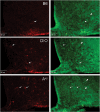Obesity induces functional astrocytic leptin receptors in hypothalamus
- PMID: 19293246
- PMCID: PMC2668946
- DOI: 10.1093/brain/awp029
Obesity induces functional astrocytic leptin receptors in hypothalamus
Abstract
The possible role of astrocytes in the regulation of feeding has been overlooked. It is well-established that the endothelial cells constituting the blood-brain barrier transport leptin from blood to brain and that hypothalamic neurons respond to leptin to induce anorexic signaling. However, few studies have addressed the role of astrocytes in either leptin transport or cellular activation. We recently showed that the obese agouti viable yellow mouse has prominent astrocytic expression of the leptin receptor. In this study, we test the hypothesis that diet-induced obesity increases astrocytic leptin receptor expression and function in the hypothalamus. Double-labelling immunohistochemistry and confocal microscopic analysis showed that all astrocytes in the hypothalamus express leptin receptors. In adult obese mice, 2 months after being placed on a high-fat diet, there was a striking increase of leptin receptor (+) astrocytes, most prominent in the dorsomedial hypothalamus and arcuate nucleus. Agouti viable yellow mice with their adult-onset obesity showed similar changes, but the increase of leptin receptor (+) astrocytes was barely seen in ob/ob or db/db mice with their early-onset obesity and defective leptin systems. The marked leptin receptor protein expression in the astrocytes, shown with several antibodies against different receptor epitopes, was supported by RT-PCR detection of leptin receptor-a and -b mRNAs in primary hypothalamic astrocytes. Unexpectedly, the protein expression of GFAP, a marker of astrocytes, was also increased in adult-onset obesity. Real-time confocal imaging showed that leptin caused a robust increase of calcium signalling in primary astrocytes from the hypothalamus, confirming their functionality. The results indicate that metabolic changes in obese mice can rapidly alter leptin receptor expression and astrocytic activity, and that leptin receptor is responsible for leptin-induced calcium signalling in astrocytes. This novel and clinically relevant finding opens new avenues in astrocyte biology.
Figures









Similar articles
-
Role of Astrocytes in Leptin Signaling.J Mol Neurosci. 2015 Aug;56(4):829-839. doi: 10.1007/s12031-015-0518-5. Epub 2015 Feb 17. J Mol Neurosci. 2015. PMID: 25687329 Free PMC article.
-
Astrocyte IKKβ/NF-κB signaling is required for diet-induced obesity and hypothalamic inflammation.Mol Metab. 2017 Jan 28;6(4):366-373. doi: 10.1016/j.molmet.2017.01.010. eCollection 2017 Apr. Mol Metab. 2017. PMID: 28377875 Free PMC article.
-
Up-regulation of apolipoprotein E by leptin in the hypothalamus of mice and rats.Physiol Behav. 2009 Aug 4;98(1-2):223-8. doi: 10.1016/j.physbeh.2009.05.013. Epub 2009 May 28. Physiol Behav. 2009. PMID: 19481557 Free PMC article.
-
Leptin action on nonneuronal cells in the CNS: potential clinical applications.Ann N Y Acad Sci. 2012 Aug;1264(1):64-71. doi: 10.1111/j.1749-6632.2012.06472.x. Epub 2012 Apr 24. Ann N Y Acad Sci. 2012. PMID: 22530983 Free PMC article. Review.
-
Control of food intake via leptin receptors in the hypothalamus.Vitam Horm. 2000;59:265-304. doi: 10.1016/s0083-6729(00)59010-4. Vitam Horm. 2000. PMID: 10714243 Review.
Cited by
-
ADORA1-driven brain-sympathetic neuro-adipose connections control body weight and adipose lipid metabolism.Mol Psychiatry. 2021 Jul;26(7):2805-2819. doi: 10.1038/s41380-020-00908-y. Epub 2020 Oct 16. Mol Psychiatry. 2021. PMID: 33067580 Free PMC article.
-
Role of Astrocytes in Leptin Signaling.J Mol Neurosci. 2015 Aug;56(4):829-839. doi: 10.1007/s12031-015-0518-5. Epub 2015 Feb 17. J Mol Neurosci. 2015. PMID: 25687329 Free PMC article.
-
C-reactive protein increases BBB permeability: implications for obesity and neuroinflammation.Cell Physiol Biochem. 2012;30(5):1109-19. doi: 10.1159/000343302. Epub 2012 Sep 27. Cell Physiol Biochem. 2012. PMID: 23018453 Free PMC article.
-
Regional astrogliosis in the mouse hypothalamus in response to obesity.J Comp Neurol. 2013 Apr 15;521(6):1322-33. doi: 10.1002/cne.23233. J Comp Neurol. 2013. PMID: 23047490 Free PMC article.
-
Astrocytes modulate distribution and neuronal signaling of leptin in the hypothalamus of obese A vy mice.J Mol Neurosci. 2011 Mar;43(3):478-84. doi: 10.1007/s12031-010-9470-6. Epub 2010 Nov 18. J Mol Neurosci. 2011. PMID: 21086065 Free PMC article.
References
-
- Abbott NJ. Cellular compositions of the blood-brain barrier (BBB) In: Kastin AJ, Pan W, editors. The Henry Stewart Talk series: the blood-brain barrier. London: Henry Stewart Talks; 2008.
-
- Abbott NJ, Ronnback L, Hansson E. Astrocyte-endothelial interactions at the blood-brain barrier. Nat Rev Neurosci. 2006;7:41–53. - PubMed
-
- Ahmed M, Shaban Z, Yamaji D, Okamatsu-Ogura Y, Soliman M, Abd EM, et al. Induction of proinflammatory cytokines and caspase-1 by leptin in monocyte/macrophages from holstein cows. J Vet Med Sci. 2007;69:509–14. - PubMed
Publication types
MeSH terms
Substances
Grants and funding
LinkOut - more resources
Full Text Sources
Medical
Miscellaneous

